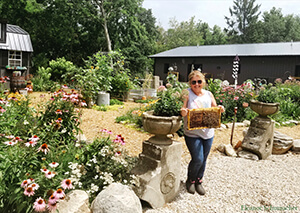
You might have a prairie! Don’t disc it or spray it!
Wouldn’t you love to have an apiary on a prairie? With a wide array of native wildflowers constantly blooming, your honey bees would always have something to munch on. It goes without saying that, as keepers of bees, our spirits lift each time we watch a honey bee clamber among brightly colored petals of flowers — even flowers we can’t name. Why do we get such a charge to see bees working varieties of blooms? Is it within our instinctual knowledge (just as it appears to be in theirs) to feel an exhilarating sense of nourishment, knowing that our bees, or bees in our environment, have a rich diet?
When we think of “good beekeeping” and “healthy colonies,” our first mental image may be that of tall hives, towering with honey supers. Building our beekeeping experience, it’s not uncommon to seek a long growing season of nectar-bearing plants that not only feed our bees but yield a maximum honey supply for us to bottle. When I started my modest beekeeping enterprise, I thought in these utilitarian terms. But along the way, I’ve realized make-or-break nuances to the nutrition value of apiary forage diameter. To put it simply, don’t limit your thinking to honey alone. When considering your forage area, think about the full spectrum of your bees’ dietary needs. Honey bees are pollinators and they need access to quality pollinator habitat if they are to function at max capacity.
There are several recently published studies casting light on the importance of pollen diversity to honey bees. We can expect to see many more such studies published in the future as researchers race to understand the intricacies that hold together our food security web — the ecosystem of pollinators. While mason bees have been shown to be the most efficient pollinators of fruit trees (Dave Hunter of crownbees.com suggests one mason bee does the job of 300 honey bees), and squash bees better pollinators of squash, gourds, and pumpkins, honey bees are recognized as being the ultimate champion pollinators of an enormous variety of plant species, from familiar landscapes filled with soybeans and clover to more rare prairie environs and pollinator habitat installations.
There is an undeniable synergy that comes together as though by magic when honey bees can plug their proboscides into native wildflowers. Beekeepers who also keep prairies, or keep bees near prairies, for any amount of time can attest to improved overwintering, stronger colony populations, and fewer overall problems (that is, if their management includes prevention and eradication of colony pests and pathogens). Honey bees have been found to be among the most effective pollinators of wildflowers, and therefore ensure excellent services to native plant species. Scientifically speaking, this synergy is a double-edged sword, because some studies examining the efficiency of honey bee pollination in native habitat also show honey bees outcompeting native bees, bringing into question the degree that honey bees could contribute to wild bee decline. For this reason, some beekeepers seeking apiaries on high-value flowering prairies are turned away.
If you are one of the lucky beekeepers that have an apiary with pollinator habitat access, consider yourself lucky. However, if you are a beekeeper only dreaming of accessing a prairie, don’t consider yourself unlucky! There have never been more information, resources, and support for beekeepers wanting to plant a community of native wildflowers, and while it’s not an overnight process, prairie and native wildflower garden installation is an uplifting experience that can bring amazing benefits to bees, wildlife, and people.
Here is another consideration: While few beekeepers happen to have prairies in their backyards, there might be more prairie out there than you would think. Some beekeepers are already situated on prairie ground and don’t realize it. There could be some prairie hiding in the grass of your own apiary right now. Discovering native wildflowers on your property is like uncovering buried treasure. Taking a year to frequently hike around your apiary’s forage diameter can open your eyes to some native gems peeking through existing vegetation at different times during the season. Prairie species can “hide away” for decades with seeds and root systems submerged in soil — suppressed by grasses, aggressive and noxious weeds, and invasive bushes. It can be surprising to realize what valuable habitat might already be present — an amazing source of nutrition for your bees and other wildlife — right under your nose. If you see wildflowers coming up randomly on your bee ground, think twice before discing and replacing with clover or buckwheat. There might be something under the grass that bees like better!
Native wildflower benefits for honey bees
Nectar flows are not the sole factor in optimizing bee nutrition. While nectar supplies sugars, bees also need proteins, lipids, and antioxidants. That’s where pollen comes in. The average bee consumes 3.4 to 4.3 mg of pollen per day. Pollen is mixed with nectar and glandular secretions to make bee bread, the ever-changing goulash that sustains nurse bees and larvae. Researchers have yet to fully understand the dynamics of bee bread and how its nutritional composition fluctuates, but several studies have identified a broad number of highly variable components. Bee bread recipes revolve around the vastly diverse nutritional and medical needs of a hive at any given time. Like a fine epicurean culinary experience, foragers gather fresh pollens of trending significance. What drives the nutritional trends at any given moment? Conditions in and out of the hive and the potential stressors in those environments.
Inside the hive, honey bees contend with a plethora of pressures. Small hive beetles, covered with fine, spiky hairs, drift from hive to hive, sometimes carrying pathogenic bacteria and fungi. Varroa mites feed on honey bee fat bodies, meanwhile spreading viruses. Miticides, especially harder chemicals like coumaphos and amitraz (or their breakdown products), can ….


